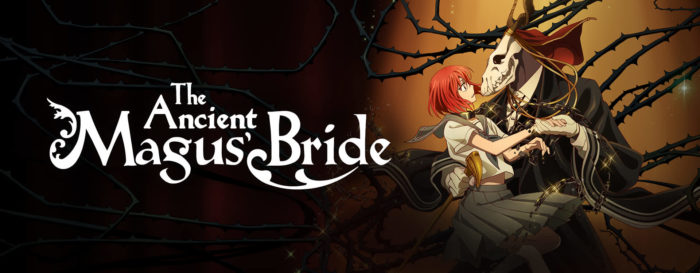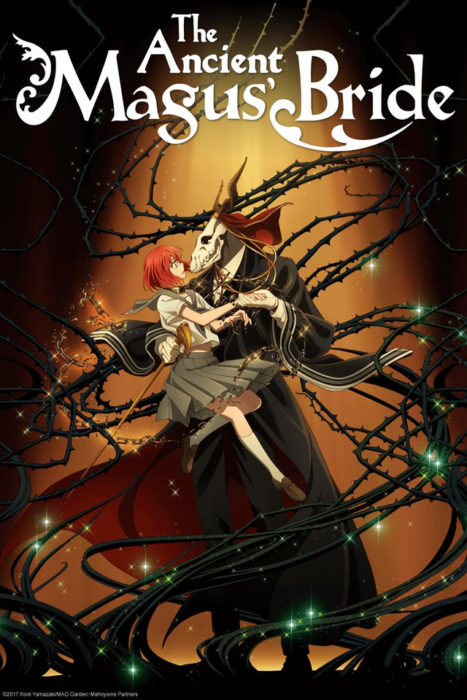The Ancient Magus’ Bride: Touch of Humanity
As The Ancient Magus’ Bride begins, Hatori Chise feels worthless.1
Shuffled from relative to relative after her father left her and her mother committed suicide, Chise no longer cares if she lives or dies. Cheery. Willing to do anything for a real home, she sells herself as a slave in a magical marketplace.
You see, Chise can see faeries and spirits and control them better than any other mage in the world, but this leaves her with a shortened lifespan. Seriously, how much more depressing could this get?
Rather than see her abused and left to die, a half-faerie mage named Elias rescues Chise. He takes her back to his home in England to be his apprentice, and perhaps someday … his bride.
Wait, what?!

Elias’s intentions are pure. He only wishes for human companionship. He is too much faerie to be human, and too human to be faerie. So, caught in the terrible twilight, he rescues a girl in the same spot in hopes of claiming some form of humanity. Under Elias’s protection, Chise dares to feel again, and finds herself surrounded by more friends than she could imagine.
Elias is the friend of the elemental creatures, and is kind and gentle, most of the time. He doesn’t quite get humans, and this is not uncommon with faeries in folklore. So Chise teaches him about empathy and other human virtues. Being formerly an Unseelie fae, Elias can’t process emotions as words, only sensations. He has to learn from Chise the names of what he feels. This is the main gist of the show, the reclamation and restoration of humanity.
Since this show is called The Ancient Magus’s Bride, and we are working with faeries and such, there is quite a bit of magic. Elias, Chise, and other mages are seen to be singing chants to the elements to make them do their bidding. Each mage also has at least one familiar, a faerie that helps them him or her do magic. In the context of this series, the familiars are there to help the mage amplify and control their magic, nothing more. So far, fortune-telling has not come up. Necromancy has come up, and is viewed as disgusting and perverted, and something no honest mage would do.
Chise’s faerie is called Ruth, a black dog that can transform into a boy about Chise’s age. He’s a boy dog, but his name is Ruth–like Babe Ruth? Anyway, ln his former life, Ruth, then Ulysse, was the pet of a girl who looked something like Chise. When his girl is killed in a tragic accident, the faithful dog stays by her grave until he too passes. Just when thought it couldn’t get more depressing! Buddhist theology teaches that humans and creatures who do good are “upgraded” upon their death into something better as a reward for their good work. In this case from a normal, if very intelligent dog to a powerful faerie that can take human form. Part of the ceremony that binds Chise and Ruth involves cutting her palm. Also some of Ruth’s lines hark back to the biblical Book of Ruth.
Many characters have Biblical names, and certain aspects of the series are associated with Christianity. One of Elias’s friends is Father Simon, a priest charged with looking after him. Elias doesn’t like it, but he doesn’t mind so long as the church doesn’t bother him. He does favors for the Church in exchange for not having people checking in on him every day. That does not stop him from helping people that Simon sends his way, doling out gentle natural medicines. Chise also goes to Simon for help when she needs it.
The Queen of the Faeries, Titania, refers dismissively to God and the Church (also not uncommon to unseelie faeries in folklore) and both she and King Oberon are morally ambiguous. Elias is put out by the Queen’s dismissal of Father Simon and the faeries’ general moral ambiguity, which is implied to be his reason for leaving Tir Na Nog. Titania says that the human world is toxic to the soul and that’s why humans age and die. (Theologically, can’t say she’s entirely wrong. Sin is toxic.) The forest god Cernunnos and his pregnant bride show up in the Christmas-themed episode for about five seconds. There are also witches who try to get Chise to join their coven in exchange for saving her life.
There are some sexual content concerns. Titania’s dress is very open at the top, leaving very little to the imagination. This pattern is repeated with Cernunnos’s bride and a faerie named Leanan Sidhe (LEE-an-NAN SHEE). Leanan lives in the garden of an elderly man named Joel, but contrary to her type (vampire) she does not hurt him. After his death, she never hurts another man again. In two episodes, Chise tends to a wounded and frightened Elias in his room. This appears to be entirely chaste, though Elias struggles not to eat Chise at one point. Chise also gives Elias a kiss on the cheek. In the first episode, Elias helps Chise get ready for a bath, and we later see her side and back, never anything more than that. Chise is humiliated, but Elias doesn’t understand her embarrassment. And this is all before they get married for real–when Chise is 16.
To his detriment, Elias shows himself to be jealous, possessive, and stalker-y at times, demanding to know where Chise is at all times. He claims it’s so he can protect her, but I have my doubts. Chise is more than capable of defending herself and Ruth does everything he can to protect her, and is often of more use than Elias. Elias does not respect Chise’s personal space, clearly not comprehending it makes her uncomfortable.
Blood is also on display, for instance if Chise uses too much magic it can cause her to vomit blood. There are also incidents of bloody violence, much of it involving Chise. Disturbing monsters and imagery abound, adding a gloss of horror to the this usually strictly urban fantasy genre anime. Recurring villain Cartaphilus (aka, the Wandering Jew) loses an arm, takes one from another man, and then tries to kill Chise. He uses parts from Ruth’s young mistress to create an undead monster. One of the minor characters, Alice used to be a drug addict, and defends herself from her former dealer. A faerie doctor fakes drowning Chise in order to heal her wounds. An Unseelie called Ashen Eye kidnaps Elias and a little boy and uses words to entrap foolish humans, including Chise. There is also the occasional swear word (strongest used is the P-word).
In all, The Ancient Magus’ Bride is a beautiful, but confused mess, much like its hero. The show has much truth and beauty, but it is spiritually confused. Much like Elias himself, it can’t escape its own web of confusion, therefore, my stamp of disapproval rests on this show. Ancient Magus’ Bride had lots of promise, but it embodies everything people criticize about “Beauty and the Beast” stories and fairy tales in general, not to mention it’s just plain depressing. Move over Phantom, Elias is going to give you a run for your money!
- This review was originally published in April 2018 at Tamra Wilson’s personal website. ↩







































I think your summation of the anime series is fair. It had potential, and also had its moments, but overall my opinion was that it was lacking.
The way it started was simply too contrived, or even worse. There had to be better ways of getting Chise to jolly old England.
The way it tried to take both the Christianity and the pagan fae seriously while also showing that they are opposed to each other simply confused the overall message.
But it also had some of the best individual scenes I’ve watched in a while, such as the last flight of the old dragon Navid, and Chise’s phoenix transformation at the end of the first season.
So, I agree that the show ends up being confused, and the “happily ever after-ish” ending didn’t really seem right.
Nerd nitpick: The Faerie Queen’s name is Titania rather than Tatiana, but I’m assuming autocorrect borked it for you.
But yeah, concur that the whole is not better than the sum of its parts, tho it does have good parts.
Great catch. Just fixed it.
When I read review like this I wonder what the author is doing watching anime aimed at adults in the first place. AMB is obviously the product of a none christian culture and it is not surprising that the messages of this and many other similar shows do not dove tail neatly with North American Evangelical Culture. That’s fine it’s not a show for everyone but to call it a ” beautiful, but confused mess” is not just harsh but betrays a reviewer who is painfully unaware of how narrow their own cultural perspective actually is.
If she meant it was a narrative mess, I could back that up. Not simple enough to be episodic, but too choppy to flow well. Also it does that annoying shounen thing where it purposely ends right on a cliffhanger-like point to spike the drama, but then it turns out to be a nothing-burger in the next episode.
Haven’t seen this show yet, so I can’t say much about it specifically. But sometimes it can be good and useful to watch shows where the characters are confused in some way or another. People are often a mess at some point in their lives, and tend not to have it all together even when they think they do. Seeing stories where people are dealing with that sort of confusion can be extremely useful for learning how to understand and deal with those sort of messes. For that reason, maybe we need some stories that show that confusion, and the characters simply being as they are, rather than expecting them to fix all their problems by the end of the story.
I think that some of the “spiritual confusion” may have to do with the story having some contradictory elements in it. It’s a story that takes Christianity to some degree seriously and even sympathetically, but it also has the more pagan world of the fae mixed in with it, and as shown the one time Titania met the priest, the two worlds are hostile to each other, a hostility the story cannot resolve.
And, in my opinion, the ending didn’t really help things. After the major issues between Chise and Elias that the last story arc brought up, the last few minutes of the last episode simply left those mostly unresolved to give a kind of happily-ever-after ending that felt contrived, that neither character was really ready for. That’s why I hope the manga will carry one past the conflict with Cartaphilus, and ignore the anime ending.
More than likely the anime is outrunning the manga. I’ve read some of the manga, but at Volume 5-6-ish, we only got so far as Chise making her wand from Nevin’s branch.